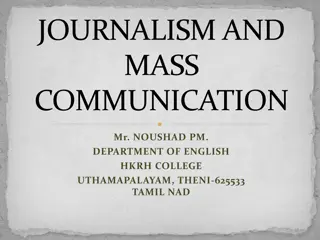The Legacy of Yellow Journalism: Joseph Pulitzer and the New Era of Press
In the early era of the press, yellow journalism emerged as a colorful and sensational form of news reporting, popularized by publishers like Joseph Pulitzer and William Randolph Hearst. Pulitzer, an immigrant to America, championed accuracy and public causes through his newspapers, such as the St. Louis Post and Dispatch and later the New York World. Despite his commitment to quality journalism, Pulitzer was not without controversies and played a significant role in shaping the standards and practices of modern journalism.
Download Presentation

Please find below an Image/Link to download the presentation.
The content on the website is provided AS IS for your information and personal use only. It may not be sold, licensed, or shared on other websites without obtaining consent from the author. Download presentation by click this link. If you encounter any issues during the download, it is possible that the publisher has removed the file from their server.
E N D
Presentation Transcript
The Early Era of the Press The number of newspapers grew during the Penny Press era until, come 1900, the number of English speaking daily newspapers (not including weeklies and foreign language dailies) grew to about 1,967. At about 1900 a new era of journalism started forming called "New Journalism. Several strains of journalism began in this era and one of them, at least, was the most colorful called Yellow Journalism.
Yellow Journalism The term came from a popular cartoon character in newspapers called "The Yellow Kid." But it is not a cartoon that the era was remembered for. Some publishers became quite sensational and bold in their news coverage. Papers were not above conducting hoaxes to trip up their competitors and doing almost anything to build circulation. Reporters would act as detectives and solve crimes ahead of police so that they could be the first to report the news. Perhaps two of the most well-known, most revered and most despised publishers of the day were Joseph Pulitzer and William Randolph Hearst. The two waged battle to become the most powerful publishers of all time.
Joseph Pulitzer Joseph Pulitzer was a Hungarian immigrant who came to America to cover the American Civil War. He ended up in Missouri. While there he purchased a dying newspaper, the St. Louis Post and Dispatch He declared that the paper would be looking out for the little guy and would become a champion for the people against special interests. He was high on accuracy and felt that accuracy, accuracy and accuracy were the three most important things about newspapers.
Joseph Pulitzer That is not to say that his paper did not have its blemishes, but he developed an outstanding reputation in the newspaper industry before moving on to New York --the then Mecca of journalism-- and bought the New York World. He hired the best reporters of the day and was the one who started running the Yellow Kid cartoon (William Randolph Hearst later stole the artist and cartoon by offering higher pay. Hearst hired him back with another pay raise.)
Joseph Pulitzer To build readership he not only ran public concern causes, he staged news stories designed to draw attention to his paper. For instance, he hired the female reporter --a novelty in itself for the time-- Nelly Bly and commissioned her to challenge Jules Vernes' book "Around the World in 80 Days." He sent her on an around-the-world trip and covered it as though it was the most important news story of the day with daily reports. A big contest was run to guess how much time it would take here. (She did it in less than 80 days.) Pulitzer was hard nosed in his demands for good journalism and today the highest awards a journalist can win for reporting are the Pulitzer Prize. Still, he could and did exhibit corporate unscrupulousness.
William Randolph Hearst Pulitzer's biggest competitor and clearly the most colorful character in American journalism was William Randolph Hearst. Hearst was born to a poor miner who came into possession of the deed for the Mother Lode silver mine, one of the richest strikes in America. He was sent to the best schools, and thrown out of them because of his practical joke personality. His father parlayed his riches into a political career in California. As was the practice of politicians of the day, he purchased several newspapers to serve as a mouthpiece for his political career.
William Randolph Hearst Hearst talked his father into letting him take over running the San Francisco Examiner. If Pulitzer's watchword was "accuracy," Hearst's was "Gee Whiz!" He felt a day was lost if there wasn't something in the paper that caused the reader to say "Gee Whiz! He experimented with printing advances and made the Examiner a powerful paper. But Hearst tired of San Francisco and moved to New York and bought the Journal. He continued his campaigning ways, but on a national scale. To make his paper stand out, he didn't just hire the best reporters of the day, he hired Pulitzer's top reporters away.
William Randolph Hearst War and Hearst were words that went together often. Many historians argue that the Spanish- American War was a result of Hearst sensationalizing news of Cuban atrocities that may or may not have happened. A popular, but probably apocryphal story is that he hired the great artist Frederick Remington to go to Cuba and supply pictures of the war there. Remington supposedly telegraphed back, "Hate to spend your money. There is no war. To which Hearst is supposed to have cabled back, "You supply the pictures. I'll supply the war." Soon after the U.S. battleship "Maine blew up in the Havana harbor. It is still a mystery as to whether the explosion was an act of war, sabotage or an accident, but suddenly we were at war with the Spanish in Cuba.
People's Champions It is difficult to classify this era solely as "Yellow Journalism" as there was much else going on. Known as People's Champions, Pulitzer and Hearst, whilst part of the power elite, used their power to fight for causes the common man would appreciate. This kind of journalism was popular outside of New York, too. One of the most well known publishers fitting into this category who resisted the lure to operate out of New York was E.W. Scripps, who ran a chain of mid-Western newspapers in the Ohio area. The papers had a spirit of protest and featured hard-hitting local editorials.
People's Champions And it wasn't just the newspapers doing this. The general interest magazines of the day -- magazine such as Cosmopolitan and Ladies Home Journal and Saturday Evening Post -- also developed a trend of reporting called muckraking. Muckraking the beginnings of investigative journalism. Writers would do long stories --some even wrote books-- uncovering the seedy side of such icons of the day as John D. Rockerfeller and Standard Oil, the Chicago beef industry, patent medicine companies and more. The term derived from the concept that the pond may look clear, but if you rake up the muck at the bottom you'll see how dirty things really are.
Jazz Age Journalism Jazz Age journalism was the precursor to tabloid journalism and left perhaps the most enduring stereotype of journalists in American's minds: Ill- educated, hard drinking slobs who would do anything to get a story, even make it up.
Exercise Q. The term yellow journalism is used to define sensational reporting, where the reporter makes too big a deal of the facts or blows the story out of proportion. Give a modern day example of where the press could be accused of yellow journalism.























